A Waterfront Gem: the Making of Brooklyn’s Domino Park
How a new green space in Williamsburg embraces its gritty industrial past with playful ingenuity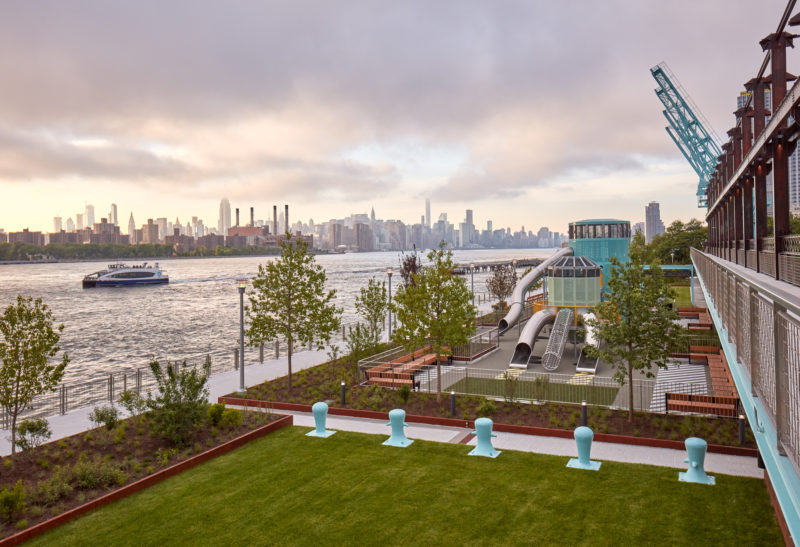
The turquoise bollards remind visitors that ships used to dock here while unloading their cargo of sugar (Photos by Daniel Levin/Courtesy of Twin Trees Management)
Walking along Domino Park, the new Williamsburg esplanade on the East River, feels a bit like being on an ocean liner. In this 100-foot-wide park, one is never far from the water and always coming upon a new experience–historical, reflective, playful, aquatic–all of it packed neatly into its six-acre space.
But you don’t have to navigate a gangway to get on board, because one of Domino’s prime features is how accessible it will be to a neighborhood that has been starved for public space and largely cut off from the waterfront. Opening Sunday, the park is the public showpiece of the multibillion-dollar redevelopment of the 11-acre Domino Sugar refinery complex, which will include residential towers, office space, and retail stores.
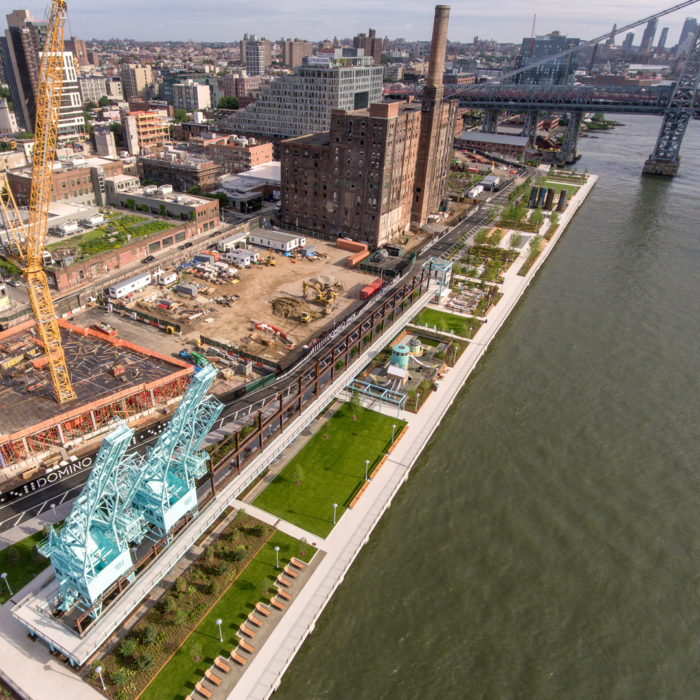
The new park stretches for a quarter mile along the East River
The park’s distinctive, post-industrial theme evokes the history of what was once the world’s largest sugar refinery. The park preserves such features as giant, turquoise-colored cranes that once unloaded raw sugar from ships arriving from the Caribbean. A catwalk, held aloft by columns that were once part of the sugar warehouse, gives park visitors a close view of the artifacts.
“I think it’s really nice for visitors to get a sensation of what happened there and why this place is different from other places,” says Jed Walentas, CEO of Two Trees Management, the Domino complex’s developer. “That plant and that infrastructure had a profound impact on the community and generations that lived there–and really the economy through all of North America.”
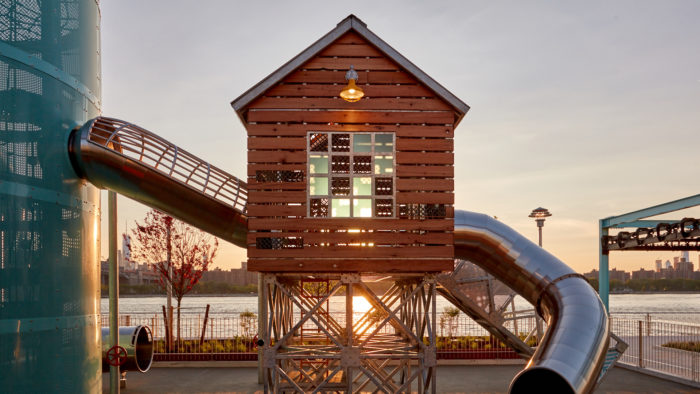
The playground is a miniature version of a sugar refinery
The factory motif is echoed throughout the park, including old conveyor screws that sprout from the ground like metallic cacti, a towering row of four rusty-blue syrup tanks, and a playground designed as a factory in miniature, “reflecting the refinery process through the eyes of a child,” says Lisa Switkin, the park’s head designer and a senior principal at James Corner Field Operations, the firm responsible for Manhattan’s High Line park.
While the park sits in a private development where a row of residential towers will rise alongside it, the park is connected to the street grid, thanks to a newly built extension of nearby River Street that runs parallel to the park. “The single biggest planning move that we made throughout the entire process was the public street,” Walentas told The Bridge. “The sad truth is that a lot of developers look at a public open-space requirement and they really want to make it an amenity for their residents as much as anything. The way to separate that out is to put in a public street.”
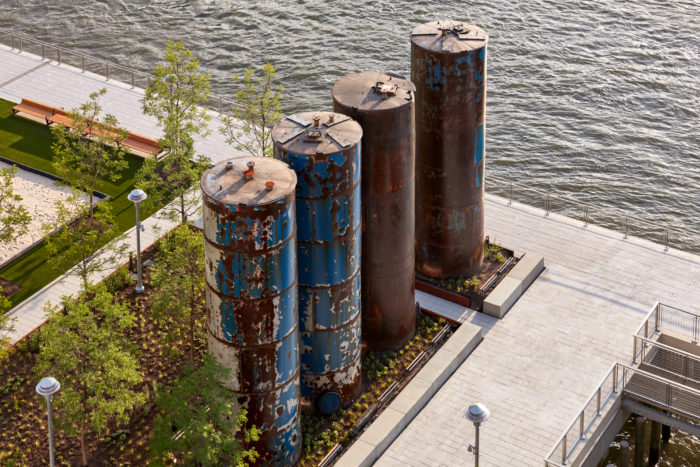
Former syrup tanks, 36 feet tall and with a rich patina of rust, stand in a row at water’s edge
The park could have turned out a lot differently. After the refinery shut down in 2004 after nearly 150 years of operation, a development company took its plans for an apartment complex through the city-approval process but then ran into financial problems. In 2012, Two Trees bought the site for $185 million and decided to rethink the plan, which led to a proposal for higher towers in exchange for more open space, including a larger, better park.
The plan was eventually approved, but not before natural disaster struck: Hurricane Sandy. Just a few days later, Two Trees executives and the park designers were scheduled to have their first major planning meeting about their waterfront creation, which now looked like a more daunting proposition.
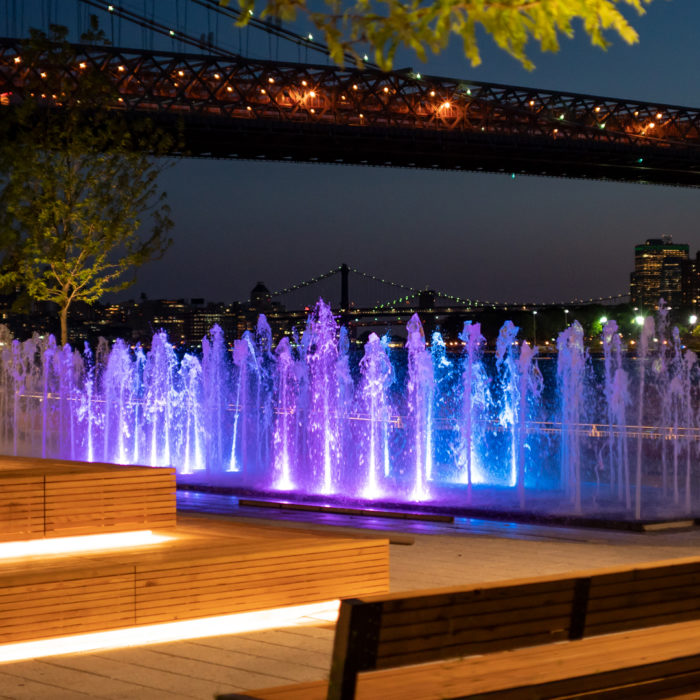
The water feature changes colors and is built for interactive play, a/k/a splashing
Recalls Switkin: “I called Jed and asked, ‘Are we still on?’ He said, ‘Come on over.'” In Dumbo, where Two Trees redeveloped much of the neighborhood and has its offices, the company was working around the clock to restore utilities to buildings that had flooded, says Walentas. “Lisa was like, ‘Is anybody home?,’ and we’re like, ‘Yeah we’re all here.’”
The park planning went on undaunted, but the hurricane inspired extra precautions in the design, including the elevation of the park by several feet. “We just sort of changed the topography. To the extent the park floods, it’s designed incredibly well to handle that, and it’ll dump all the water back in the river,” says Walentas. “The materials that we’ve used and the plantings that Lisa and her team picked will survive.”
“A lot of people had talked about storm events and resiliency as being concerns or negatives” about waterfront development, says Walentas. “I really don’t feel that way. I don’t think people’s desire to both live and work and play along the water either in this city, or in other cities, is going to go away.”
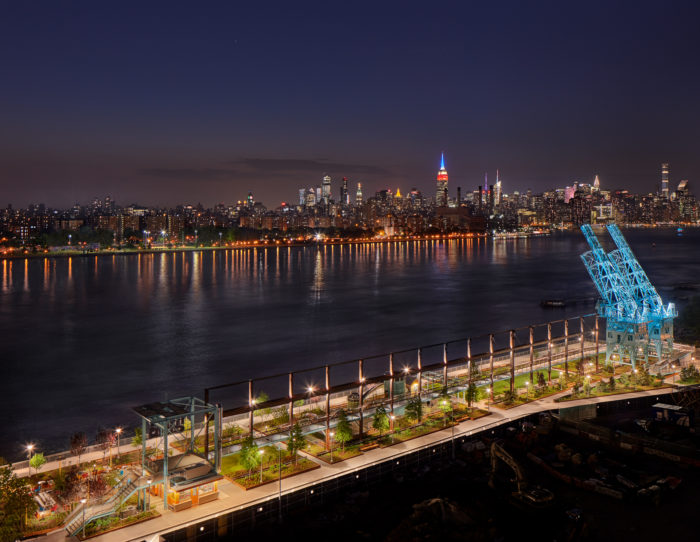
On a clear night, the park has a marvelous view of Midtown
The park, of course, is all about the recreation. What kinds to include in a limited space? After consulting with members of the surrounding community, the planners decided on a picnic area, a volleyball court, bocce courts, a dog run, and interactive water jets, suitable for splashing around. A wooden, tiered, mini-amphitheater is situated right across from the towering brick smokestack of the old refinery. “It’s a very powerful place to be,” said Switkin.
Other features are less expected, including what Switkin calls the “pier reveal,” where pedestrians cross over a gap with the East River swirling below (and water-misting jets adding to the aquatic experience).
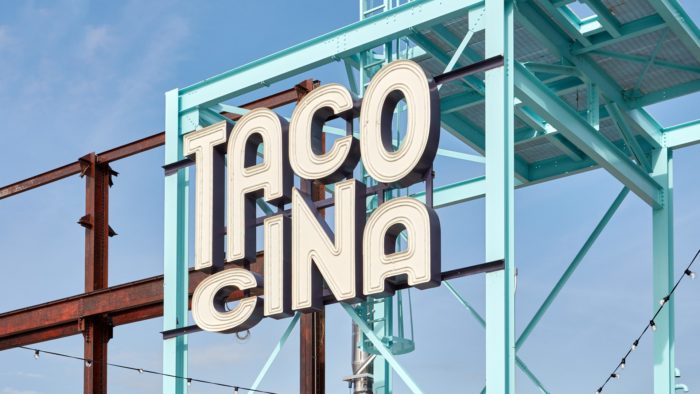
Tacocina will be open seven days a week, from 11 a.m. to 10 p.m. on Sun-Thurs, 11 a.m. to 11 p.m. Fri-Sat, with plenty of picnic tables out front
Since Two Trees built the park and is committed to its upkeep in perpetuity, the developer didn’t skimp on materials and workmanship. “We’re going to maintain this park forever and you don’t want the park to look shitty two or three years after it opened,” says Walentas. “There’s a balance between having things be beautiful and also having them be durable, having them be safe. Hopefully, we found the right balance.”
Near the center of the park will be a walk-up food stand, Tacocina, run by famed restaurateur Danny Meyer’s Union Square Hospitality Group. Not just any taco shack, Tacocina will press its own tortillas to order, using a heritage breed of corn from Oaxaca. The tortilla has “got a different flavor to it,” Meyer told the Wall Street Journal. “I hope people will like it.” Margaritas will be available too.
In the end, the measure of the park’s success will be in its visitors. “We’ll really judge ourselves on how many people use it, how many families use it, how beloved it is by the community,” says Walentas. “Hopefully everyone will feel incredibly welcome there.”










